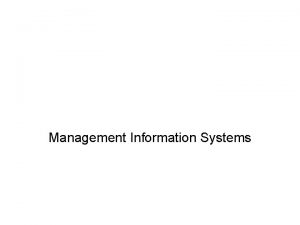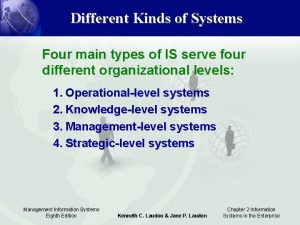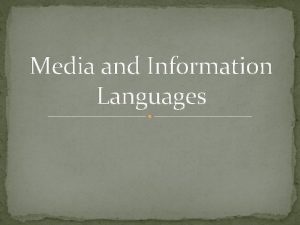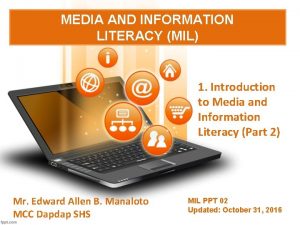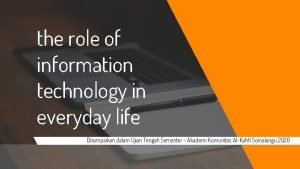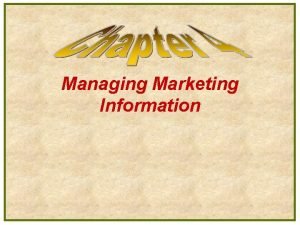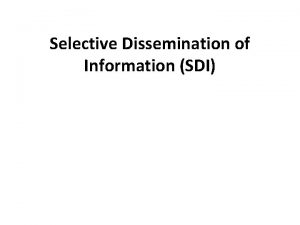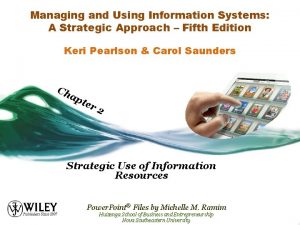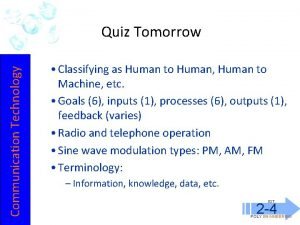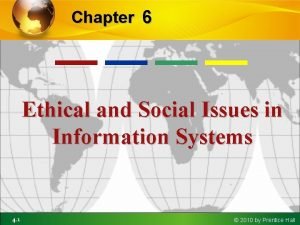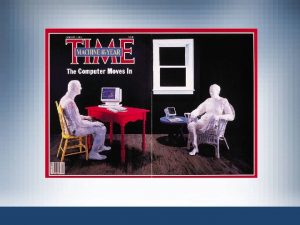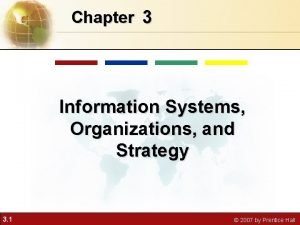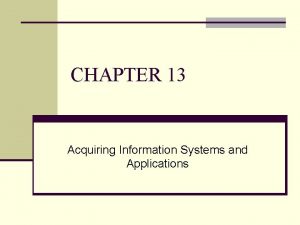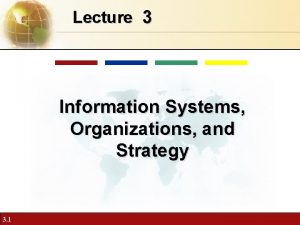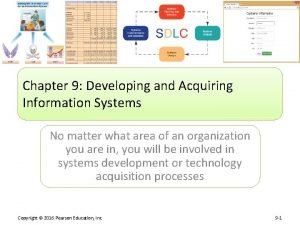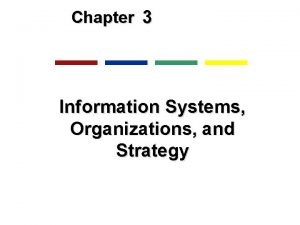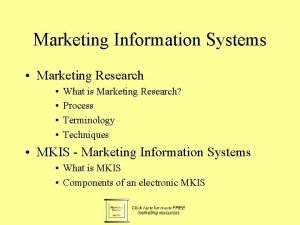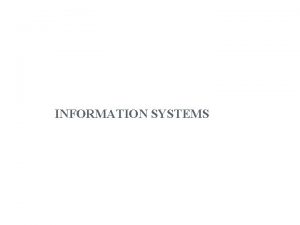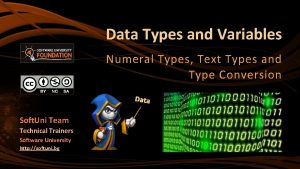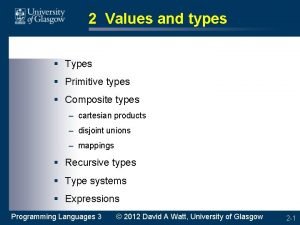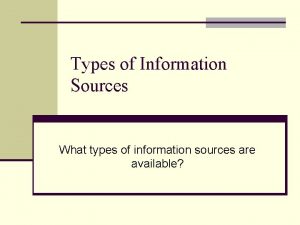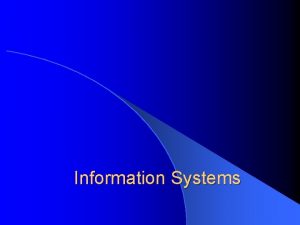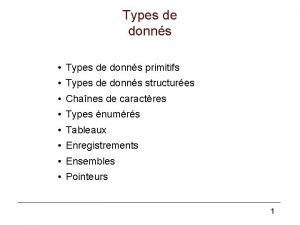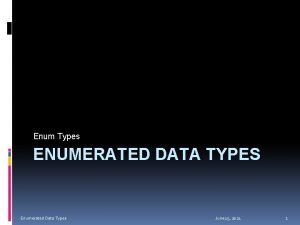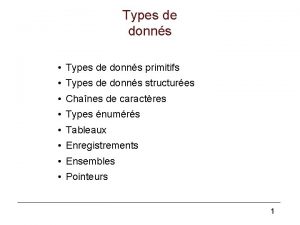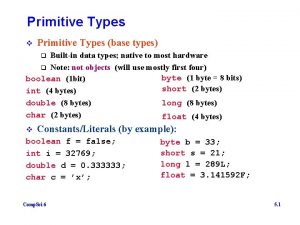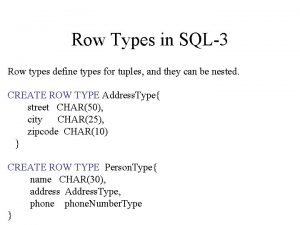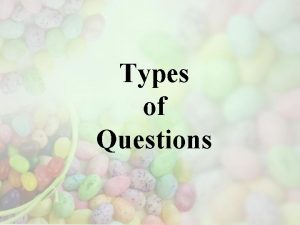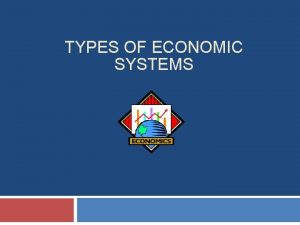Information Systems Types and Importance of Information systems





























- Slides: 29

Information Systems Types and Importance of Information systems 1

Objectives Importance of information systems 4 levels of users (filtering info) Information system types Different decision types 2

Why? Understand your role in a system better Know what systems are available to you Be a better user to the IT group Make good IT management decisions Info Systems cost A LOT of money 3

The Competitive Advantage GOOD Access to a world market Improve quality Aid employee communication Reduce costs Increase productivity Improve company morale Serendipito us Surfing: Politics 4

Cost, Risk, and Change - BAD IT solutions can be expensive and time consuming Element of risk in the implantation of IT Implementing IT means change 5

Information Quality (GIGO) Accessibility Completeness Timeliness Relevance (Information overload) 6

Business System Model Plan Organize Lead Control Strategic Management Tactical Management Operational Management Clerical Level Resources Employees Managers Products & Services Functions Government Customers Stockholders Financial Institutions Colleges/ 7 agencies Media

Filtering Information The right information - the right decision maker - the right time - the right form. Clerical Level (Transaction Handling) Operational Level (Exception Reports) Tactical Level (What-if Reports) Strategic Level (One-time Reports, What-if Reports or Trend Analyses) 8

Making Decisions Well-Defined Problem Programmed Decisions Unstructured Problem Information-Based Decisions 9

What Can Info System Do? Input Source Data Inquiry Response to prompt Instruction Message Change Processing Retrieve Record Update Summarize Select Manipulate Output Hard copy Soft copy Control Storage Data Text Images Other digital information 10

Information System Types Manual system No hardware No software 11

Transaction Processing Systems (TPS) Activities: Transaction handling Record-keeping Action documents Scheduled reports Primarily support: MIS DSS EIS Clerical personnel Operational-level managers Inflexible 12

Management Information System An MIS is a computer-based system that optimizes the collection, transfer, & presentation of information throughout an organization by using an integrated structure of databases & information flow. My Definition: System used to support management activities 13

MIS vs. DP MIS offers greater flexibility MIS integrates the information flow MIS caters to information needs of all management levels MIS are more timely and have online inquiry capabilities Boosts system security Management focused reports MIS uses an integrated database 14

MIS In Action Airline Reservation System (also, Inventory Control) 15

Decisions Support Systems interactive integrated set of hardware and software tools produce information to support decisionmaking process 16

DSS vs. MIS: structured problems designed to support a set of applications DSS: semistructured and unstructured problems can be adapted to any decision environment 17

DSS Characteristics Helps decision maker Semistructured & unstructured problems Most effective for tactical & strategic management levels Interactive and user-friendly; little IT help needed more. . . 18

DSS Characteristics Uses models, simulations, & analytical tools Readily adaptable to any decision environment Interacts with a corporate database Not used for pre-established production schedule Often makes helpful charts EX: Forecasting; Chase MIS statistics warehouse analysis 19

DSS Tool Box Applications Development Quick application building Throwaway systems Support a one-time decision Data Management Data Warehousing (combine and offer preset relationships) Data Mining (search warehouse for new relationships) more. . . 20

DSS Tool Box Modeling Decisions involve many factors Uncertainty and risk present Statistical Analysis Risk Analysis Trend Analysis Planning What-If Goal Seeking more. . . 21

DSS Tool Box Inquiry Graphics Consolidations Application-Specific 22

EIS – DSS with a twist Executive Information System Just DSS for executives Each tool is designed specifically to support decision making at the executive levels of management Primarily the tactical and strategic levels 23

Expert Systems An Expert System is an interactive system Responds to questions Asks for clarification Makes recommendations Helps the user in the decisionmaking process Simulates human thought process Reasons, draws inferences & makes judgments (heuristic knowledge) Information acquired from live domain experts Highest form of knowledgebased systems, not an assistant system 24

Expert System Example Printer - Replace technical support people Diagnosis help (you relate symptoms and it asks for more info) Assistant system (call center; life ins quotes) Knowledge base contains Means of identifying problem Possible solutions How to progress from problem to solution 25

Intelligent Agents Type of artificial intelligence Agent may work on: An ongoing goal An action triggered by an event A one-time goal Internet intelligent agents growing Scan internet for best price Sort through e-mail for call center Scan internet or a few databases for best vacation possibility 26

INFORMATION SYSTEMS Manual Data Processing – Filing cabinet MIS – Timely inquiries, focused reports DSS – interpret unstructured facts, what if Expert Systems – move user through process Intelligent Agents – event triggers 27

Objective Summary Different decision types Structured, semi-structured, unstructured 4 levels of users (filtering info) Clerical, operational, tactical, strategic information system types Manual, DP, MIS, DSS, (EIS) Expert, Intelligent Agent Importance of information systems $$ 28

MIS Solution Workshop Customers are complaining that orders are arriving late. Five people handle customer service e-mail every day, sending some standard replies and forwarding the rest. They cannot keep up with the volume. You run the customer service department for a retail bank. People are currently on hold for over 20 minutes sometimes. You are the CEO of a small company. You are planning your budget for next year, and you need to know how much income to expect in the next year. You have been calculating this manually in the past.
 Management information system topics
Management information system topics Voyage estimating decision support system
Voyage estimating decision support system Voyage estimating decision support system
Voyage estimating decision support system Marketing information system kotler
Marketing information system kotler Types of information system
Types of information system Importance of media and information languages
Importance of media and information languages Cartoon analysis media
Cartoon analysis media Claim of fact example
Claim of fact example Importance of information system
Importance of information system Role of information technology in our daily life
Role of information technology in our daily life Importance of marketing information
Importance of marketing information Features of selective dissemination of information
Features of selective dissemination of information Importance of management information system
Importance of management information system Decision support systems and intelligent systems
Decision support systems and intelligent systems Managing and using information systems
Managing and using information systems Social issues in mis
Social issues in mis Information systems and communication technologies quiz
Information systems and communication technologies quiz Ethical and social issues in information system
Ethical and social issues in information system Knowledge management and specialized information systems
Knowledge management and specialized information systems Information systems, organizations, and strategy
Information systems, organizations, and strategy Methods of acquiring information system
Methods of acquiring information system Information systems, organizations, and strategy
Information systems, organizations, and strategy Acquiring information examples
Acquiring information examples Chapter 4 ethical and social issues in information systems
Chapter 4 ethical and social issues in information systems Information systems, organizations, and strategy
Information systems, organizations, and strategy Finer segmentation strategy
Finer segmentation strategy Marketing information systems and marketing research
Marketing information systems and marketing research Marketing information system and marketing research
Marketing information system and marketing research Marketing information systems and marketing research
Marketing information systems and marketing research Marketing information system kotler
Marketing information system kotler
